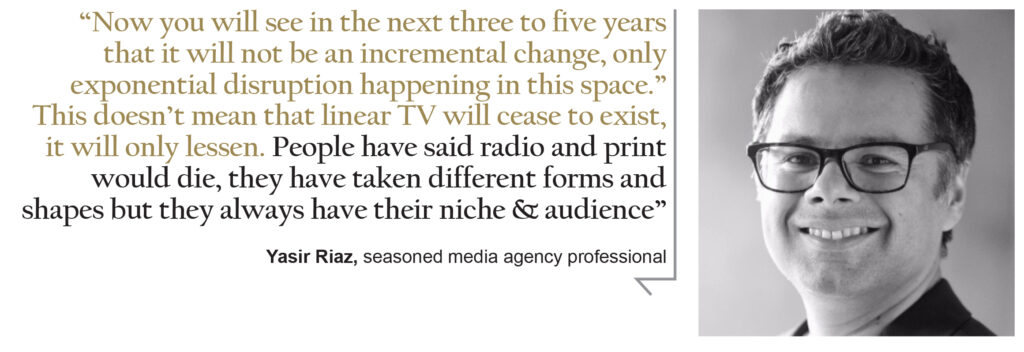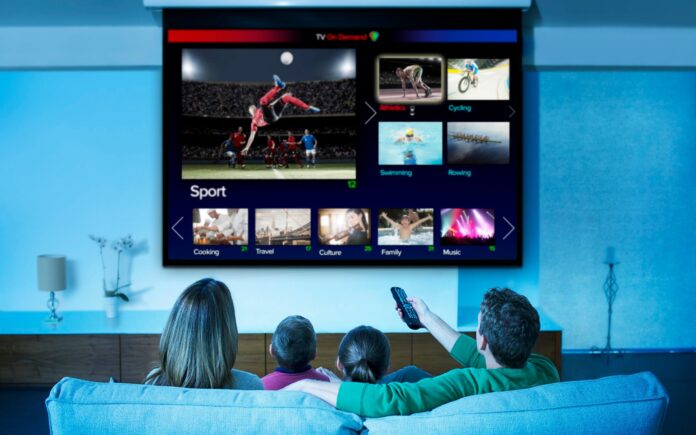During the first half of 2020, executives in the media agency space told Profit that investments were underway by broadcasters to introduce an over the top (OTT) content platform as internet penetration in the country has grown. By the second half of 2020, sources told Profit that an original equipment manufacturer (OEM) was bringing a connected television (CTV) solution to the country, capitalizing on media consumption research which suggests that audiences are increasingly looking for ways to view online content on larger screens.
It would appear that both market rumours are true, with Bee Squared Pte Ltd working on its own CTV business coupled with an OTT content platform that merges with programmatic advertising and real-time e-commerce as sources of revenue. The media holding group is the parent company for Dial Zero, Brainchild Communications, Blitz Advertising, Starcrest Communications, PakMediaCom, and MHoldings.
On the siloed side, Malaya United Films & Entertainment is working on a premium OTT platform called Mufe Pakistan which intends to include original content featuring big budget productions taking place in Australia and Pakistan. At the same time, sources at Samsung have shared that the South Korean multinational conglomerate intends to bring its unique advertising solution to the Pakistan market.
The information comes just as the audience measurement deal between PTCL and Medialogic is expected to produce its first research report, which is expected to help Etisalat-owned communications company make a case for its ability to help advertisers reach new audiences across all connected devices – beyond just cable or satellite subscribers.

With the majority of Pakistan using an Android device, with Samsung comprising the lion’s share, the company intends to roll out its addressable CTV monetisation solution called Samsung Ads, which was prominently showcased at CES 2021 this year along with launching a measurement solution.
“Samsung is in the final stages of mapping out its advanced TV advertising solution for the Pakistan market,” said a source at the company. “Much like Google, advertisers will be able to combine the first party and third party data they have about their audiences with the proprietary data of Samsung Ads to know who saw the ad, who didn’t, and on which device – laptop, mobile, tablet, or watching OTT.”
Akin to the HP strategy for selling ink cartridges at a premium price for life – by undercutting the price of the printer itself – Samsung intends to create affordable CTVs for the Pakistan market to improve its targeting capabilities across demographics, interests, and devices for its demand side platform (DSP).
“The company intends to pitch its DSP to media agencies all over the country, as a one-stop solution for video campaigns across linear TV, CTV, mobile, and desktop, all in one platform,” said an account leader for a Publicis media agency in the country. “By the end of 2021, the company intends to have access to 25 million households across Pakistan and offer advertisers & agencies the ability to directly access Samsung Ads proprietary data, audiences, and inventory, managing the reach and frequency of their video campaigns.”
Critics have been quick to point out that Samsung is making its addressable TV play at a time when digital media is on the cusp of eating mainstream media’s lunch.
The pitch deck for Samsung DSP addresses this by claiming help advertisers target households who were exposed or unexposed to linear – cable, satellite, antenna – ad creative, seamlessly incorporate linear ad exposure into your household frequency cap to manage frequency across all ad formats, and understand which audiences are being reached by any device or platform, like linear TV, OTT or mobile/desktop.
In an interview with Media Buoyz, seasoned media agency professional Yasir Riaz remarked that linear TV will remain dominant in Pakistan for at least another five years, adding that even though it may have slumped in advanced markets, Netflix has launched a linear offering. Even with all the advancements with OTT and on-demand offerings, they cannot execute live broadcasts which by its nature only linear TV can.
Riaz follows the school of thought that the shift from linear TV to OTT and on-demand in Pakistan is predicated on a generational shift, positing that the mass media industry will shift its approach to content distribution once Generation Z matures in the workforce.
“Now you will see in the next three to five years that it will not be an incremental change, only exponential disruption happening in the space,” said Riaz. “This doesn’t mean that linear TV will cease to exist, it will only lessen. People have said radio and print would die, they have taken different forms and shapes but they always have their niche & audience.”
Is the market ready?
Data on Google Trends shows that the topic of programmatic advertising saw its first spike of interest from users in Pakistan around late 2015. Two years later, GroupM launched the first regional office for its programmatic audience data buying company Xaxis, and since then the topic has frequently grown in search volume.
Since its inception, Xaxis has reportedly delivered triple digit growth year over year, going from four to forty advertisers in under three years that utilise various programmatic formats. In the same time period, the Xaxis team in Pakistan went from a single member to a team of six across two cities.
Ghulam Jilani Kothari, the newly promoted business director for Xaxis, told Profit that in order for him to recommend the addressable CTV solution by Samsung to his clients, he would need to know which platform inventory will be solved on, what the ad formats will be, which exchanges will have access to said media inventory, the specifics on audience targeting, and the state of placements including the fill rate.
“[My decision to recommend Samsung Ads depends] if the platform has any integration with a DMP or not,” he said. “If an advertiser can target bespoke audiences or not. Will an advertiser step out of its existing DSP or the advertiser can buy inventory from the same sources?”
Another point of concern is the amount of existing advertising fraud in the media ecosystem of Pakistan – whether it be on TV, radio, print, or digital – with advertisers taking the word of media measurement companies that are being paid by the media owners. As a result, exact reach, circulation, viewership, listenership, and audiences are unknown nor are media consumption reports questioned or dissected.
In light of this, a member of the Publicis Media Exchange in Pakistan told Profit that if advertisers are not careful, they can face serious ad fraud in the CTV space with plenty of examples from 2020 to be wary of.
These include DiCaprio in January, Monarch in March, IceBucket in April, and MultiTerra in September, with video advertising costing nearly ten times more than other connected formats, which attracts fraudsters. Ad fraud expert Dr. Augustine Fou said that pandemic provided additional cover for an increase in CTV fraud, because everyone believed humans staying at home stream more.
An investigation by Oracle found that ad fraud was committed on CTV through bots pretending to be legitimate apps and devices, bouncing the data center traffic through residential proxies to make it appear to come from millions of households, and rotating among thousands of apps and internet-connected TV device models to disguise the fraud.
The only digital advertising fraud detection solution in the Pakistan market at the moment is Spider Labs, operating through TikTok reseller Jack of Digital, and it is unclear whether the solution can pivot to detecting CTV ad fraud. For now, digital media buyers will need to be wary of unusual media consumption patterns and consider advice from App Science on the matter.
In a nutshell different content is streamed at different times by humans, which is reflected in the data. For advertisers investing in CTV advertising, having thorough analytical processes is the key to reducing ad fraud because black box fraud detection technologies cannot detect fraud in this channel properly.
“That tech can’t be trusted anyway, because you have no way to verify whether they measured the fraud correctly or not,” said Dr. Fou. “The tech might be missing most of the fraud. Having a trusted partner that continuously looks for fraud, to ensure your campaigns remain as clean as possible, makes it unnecessary to pay for fraud detection tech that doesn’t work. A partner that has deep experience looking at analytics can spot fraud even when the tech can’t see it.”
The other concern in the Pakistan market is the affordability of internet services costs for the end user considering the additional load brought about by a CTV in the home, coupled with the nation-wide track record of unreliable internet service providers. On a daily basis, social media accounts for PTCL and Transworld are bombarded with messages pertaining to dropped connections. The rage would undoubtedly be amplified if a drop in service quality impacts the ability of a family to stream at ease.
If advertisers and agencies are expected to get on board with CTV advertising, they need assurity that ads will run when they were scheduled to and to the audiences that they were meant for.










Compliments Babar Khan Javed to the contents in an era when the Cord is about to cut by PEMRA. Our streets, homes, colonies, societies cramped with Cables bunch hanging on Electric Poles, crossings, neither are regulated. The OTT trust PEMRA to subsidise the OTT to make it accessible to most readers. Lets hope for a better tomorrow with todays lessons.